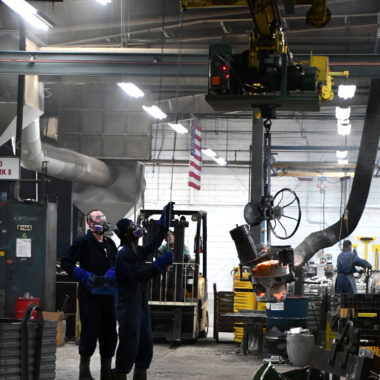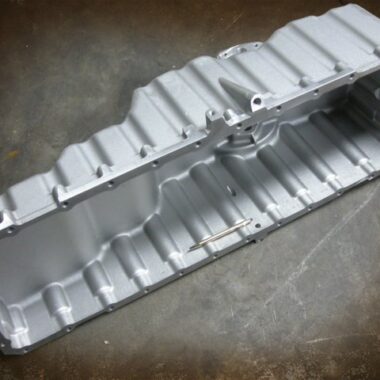Study the World of Light Weight Aluminum Spreading: Recognizing the Various Methods
Aluminum spreading is an essential process in the manufacturing market, with different methods used to produce complex and accurate elements. Understanding the various methods used in aluminum spreading can supply important insights right into the capabilities and constraints of each technique. From the conventional sand spreading technique to the advanced die casting process, each approach provides one-of-a-kind benefits depending on the demands of the job. Exploring these varied methods can use a detailed sight of the possibilities within the globe of aluminum spreading and how each method adds to shaping the modern-day manufacturing landscape.
Sand Spreading Technique
Sand casting, a widely-used method in light weight aluminum spreading processes, entails creating molds made of compressed sand for putting liquified metal. As soon as the mold is ready, it is securely positioned in a flask and molten light weight aluminum is poured right into the tooth cavity.
After the metal has cooled and solidified, the sand mold is broken away to disclose the light weight aluminum casting. Sand casting permits the production of intricate forms and big parts that may be pricey or tough to create using various other approaches. It is also a lasting method as the sand can be recycled and made use of numerous times, minimizing waste in the spreading process.
Permanent Mold And Mildew Method

One substantial benefit of the Long-term Mold Method is the enhanced dimensional accuracy it provides. The metal mold and mildew permits tighter tolerances and finer information in the last aluminum castings compared to sand casting methods. This precision makes it a preferred option for applications where limited dimensional control is critical, such as in the automotive and aerospace sectors.

Pass Away Casting Refine

Financial Investment Casting Strategy
Making use of an accuracy spreading method, Investment Casting Approach involves developing detailed light weight aluminum parts by pouring liquified steel into a ceramic mold. This process, additionally referred to as lost-wax casting, begins with the production of a wax pattern of the wanted part. This wax pattern is then coated with a ceramic material to create a covering. When the ceramic covering is set, it is heated up to remove the wax, leaving behind a hollow ceramic mold and mildew.
Financial investment casting is frequently utilized for manufacturing components in markets where intricate styles and limited resistances are called for, such as aerospace, automotive, and medical tools. The adaptability and accuracy of the Financial investment Casting Approach make it an important method in the globe of aluminum spreading.
Lost Foam Casting Technique
Having checked out the elaborate precision of Investment Casting Approach, the emphasis currently moves to the ingenious approach of Lost Foam Spreading in light weight aluminum element manufacturing. Lost Foam Casting, additionally known as evaporative pattern casting, is a modern technique where a foam pattern of the wanted component is produced and then covered with a refractory product.
One of the main benefits of Lost Foam Spreading is its capability to produce complex shapes with detailed information, typically in a single item without the demand for extra machining. This technique is also recognized for its high dimensional accuracy and smooth surface coating. Additionally, Lost Foam Spreading is a cost-efficient process as it reduces the demand for cores and enables the manufacturing of light-weight components. In spite of its benefits, Lost Foam Casting calls for cautious control of the casting procedure to avoid issues and navigate to this website make certain high quality parts.
Final Thought
In conclusion, light weight aluminum spreading offers a range of approaches such as sand casting, long-term mold and mildew technique, pass away spreading, investment casting, and lost foam spreading. Each method has its own benefits and applications, making light weight aluminum casting a versatile and widely utilized procedure in different industries. Comprehending the distinctions in between these approaches is essential in choosing one of the most suitable casting technique for certain manufacturing needs.
Sand casting, a widely-used technique in light weight aluminum spreading procedures, entails developing molds made of compacted sand for pouring molten metal. aluminum casting.The Long-term Mold Method, like sand casting, is one more widespread redirected here approach used in light weight aluminum spreading procedures, offering unique advantages in terms of mold reusability and dimensional accuracy. The metal mold and mildew allows for tighter resistances and better details in the last light weight aluminum castings compared to sand casting methods. The 2 major kinds of die spreading are cool chamber pass away spreading and hot chamber die casting, each suitable for various kinds of light weight aluminum alloys.In final thought, light weight aluminum casting provides a variety of methods such as sand spreading, permanent mold and mildew strategy, die casting, investment spreading, and shed foam spreading
Comments on “Revolutionize Your Manufacturing with Aluminum Casting Innovations”